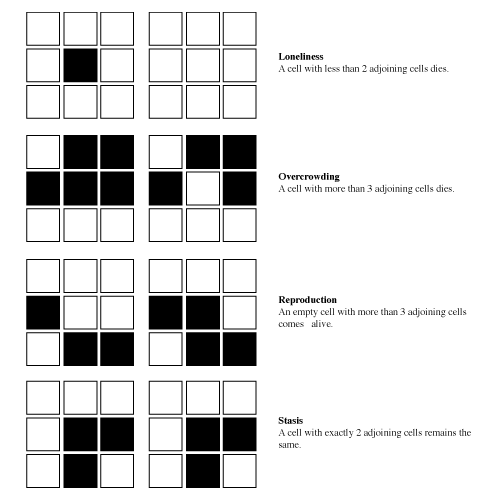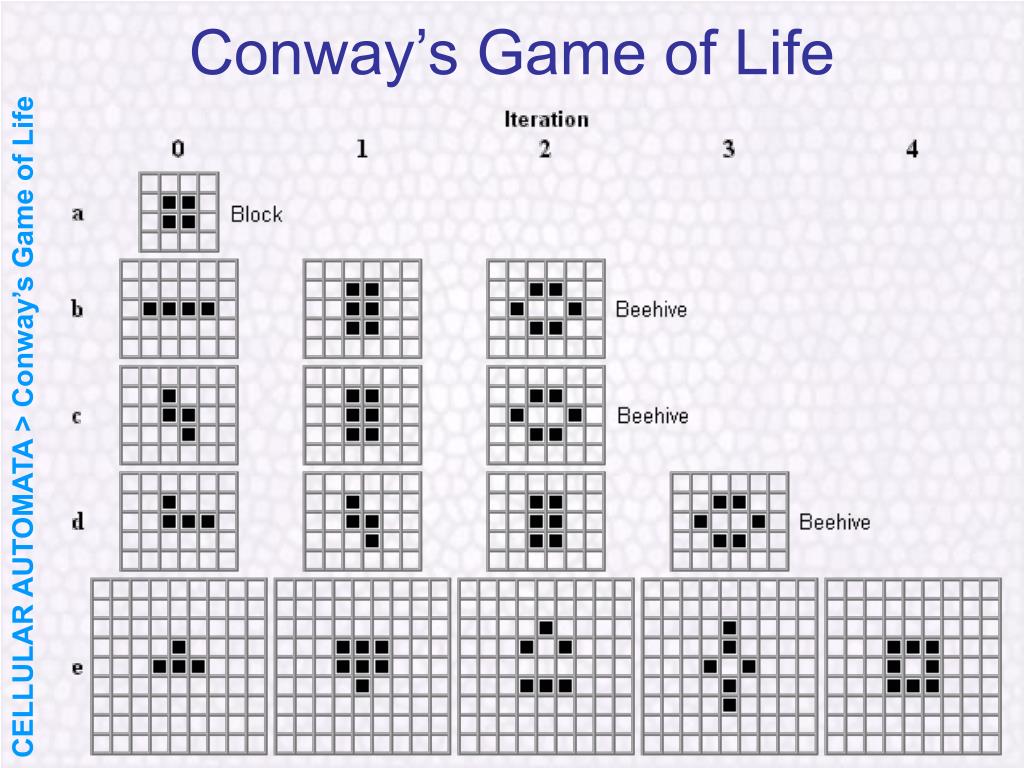

Even though its (simple) rules are specified at the level of individual cells, one sees entities at coarse-grained ‘higher’ levels of description, whose behaviors are better described by rules at these higher levels. One reason for its appeal is that it is very simple to program, yet at the same time it appears to exemplify emergent and self-organized behaviour. First popularized in 1970 in the Scientific American (Gardner, 1970), the Game of Life has attracted lasting appeal among both scientific and amateur communities. Following specification of an initial configuration, patterns evolve over time across the grid requiring no further user input (thus ‘zero-player’). It takes place on an infinite two-dimensional grid in which cells can be ‘on’ (alive) or ‘off’ (dead), and is defined by a set of rules that jointly determine the state of a cell given the state of its neighbours. The Game of Life (sometimes known simply as Life) is an example of a cellular automaton and a zero-player game. Izhikevich, Editor-in-Chief of Scholarpedia, the peer-reviewed open-access encyclopediaĭr.

If memory is True, then plot the matrix sum of all previous iterations """ if memory : plt. plot ( memory = plot_memory ) def plot ( self, memory : bool = False ): """ Plot the world. world, old_world ): break old_world = np. procreate () # stop if the world has stabilized if np. world ) for _ in range ( n_iter ): if not np. n_iter: number of iterations plot: if True, plots each iteration plot_memory: if True, plots matrix sum of all previous iterations + current iteration instead of just the current iteration """ old_world = np. world def iterate ( self, n_iter : int, plot : bool = False, plot_memory : bool = False ): """ Runs the world and plots. kernel, mode = 'constant' ) # checks which dead cells have enough live neighbors to come back alive in the next round birth_filter = np. float64 ) # finds the sum of the values of the neighbors neighbors = convolve ( new_world, self. get_kernel () def procreate ( self ): """ calculates the next round, params same as iterate """ new_world = np. set_parameters ( parameters ) def set_parameters ( self, parameters ): self. ndarray, parameters : Parameters, cmap : str = "gray" ): self. and, of course, running multiple rule sets one after each other on the same start gridĬlass CellularAutomata : def _init_ ( self, init_world : np.giving a cell more than 2 possible states.using floats instead of ints to weight the influence of each neighbor.changing the size and dimensions of the neighborhood.A short and woefully incomplete list of possible changes to these initial rules:

The initial plan was to get the game of life running and then jump straight into building logic gates, but the rule system was so incredibly simple and extensible that it was just crying out to be experimented with. You can initialize the grid with any pattern of 1s and 0s. This means a cell is born if it has 3 neighbors and survives a round if it has 2 or 3 neighbors, otherwise it dies. The rule system for the game of life is commonly described as B3/S23. The neighbors of a cell are the ones adjacent (diagonally or orthogonally) to it, i.e a 3x3 grid with the cell in the center. Here’s a quick rundown of the rules: Each cell in the grid is either dead (0) or alive (1).

This stackexchange post where some brilliant people, when tasked with getting Tetris to run inside game of life, decided to build a whole computer inside it which, incidentally, could play Tetris. We started playing around with it after seeing this post about a game of life instance running inside game of life, and It’s a cellular automata system renowned for it’s elegantly simple rules and the incredible complexity it produces. Everyone who’s interested in programming has probably had a brush with Conway’s Game of Life in some way or the other.


 0 kommentar(er)
0 kommentar(er)
